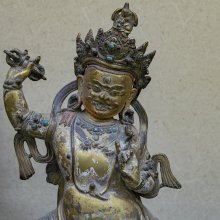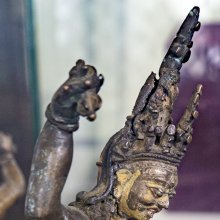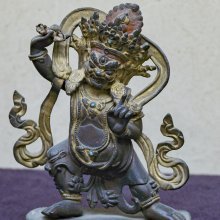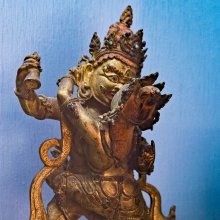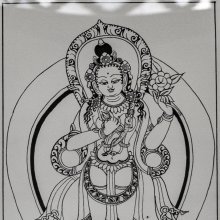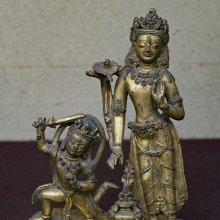Vajrapani, Vajrapāṇi, Vajrapāṇī, Vajra-pani: 22 definitions
Introduction:
Vajrapani means something in Buddhism, Pali, Hinduism, Sanskrit, the history of ancient India. If you want to know the exact meaning, history, etymology or English translation of this term then check out the descriptions on this page. Add your comment or reference to a book if you want to contribute to this summary article.
Images (photo gallery)
(+43 more images available)
In Hinduism
Ayurveda (science of life)
Rasashastra (Alchemy and Herbo-Mineral preparations)
Source: Wisdom Library: Rasa-śāstraVajrapāṇi (वज्रपाणि) or Vajrapāṇirasa is the name of an Ayurvedic recipe defined in the fourth volume of the Rasajalanidhi (chapter 7, enlargement of spleen [plīhodara] and liver [yakṛdudara]). These remedies are classified as Iatrochemistry and form part of the ancient Indian science known as Rasaśāstra (medical alchemy). However, since it is an ayurveda treatment it should be taken with caution and in accordance with rules laid down in the texts.
Accordingly, when using such recipes (e.g., vajrapāṇi-rasa): “the minerals (uparasa), poisons (viṣa), and other drugs (except herbs), referred to as ingredients of medicines, are to be duly purified and incinerated, as the case may be, in accordance with the processes laid out in the texts.” (see introduction to Iatro chemical medicines)

Āyurveda (आयुर्वेद, ayurveda) is a branch of Indian science dealing with medicine, herbalism, taxology, anatomy, surgery, alchemy and related topics. Traditional practice of Āyurveda in ancient India dates back to at least the first millenium BC. Literature is commonly written in Sanskrit using various poetic metres.
In Buddhism
Tibetan Buddhism (Vajrayana or tantric Buddhism)
Source: Wisdom Library: Tibetan BuddhismVajrapāṇi (वज्रपाणि) is the name of a Bodhisattva mentioned as attending the teachings in the 6th century Mañjuśrīmūlakalpa: one of the largest Kriyā Tantras devoted to Mañjuśrī (the Bodhisattva of wisdom) representing an encyclopedia of knowledge primarily concerned with ritualistic elements in Buddhism. The teachings in this text originate from Mañjuśrī and were taught to and by Buddha Śākyamuni in the presence of a large audience (including Vajrapāṇi).
Source: archive.org: The Indian Buddhist Iconography1) Vajrapāṇi (वज्रपाणि) is the name of the Bodhisattva offspring associated with Akṣobhya: one of the Dhyāni-Buddhas, according to Vajrayāna or Tantric Buddhism.—His colour is blue; and his symbol is the vajra.—The Bodhisattva Vajrapāṇi with the Vajra symbol is the spiritual son of the Dhyāni Buddha Akṣobhya who is the progenitor of the Vajra family. His spiritual mother is Māmakī. Vajrapāṇi, when represented, either stands or sits and carries usually a lotus on which is placed the family symbol of Vajra. Sometimes he holds the Vajra against the chest in one of his hands.
Vajrapāṇi as the name of a Bodhisattva commonly depicted in Buddhist Iconography, and mentioned in the 5th-century Sādhanamālā.—his color is white; his symbol is the vajra. Vajrapāṇi is described in the Sādhanamālā (Lokanāthsādhana) as follows:—
“Vajrapāṇi is of white colour, carries the Vajra in one hand and displays the Abhaya-mudrā in the other”.
2) Vajrapāṇi (वज्रपाणि) or Vajrapāṇilokeśvara refers to number 105 of the 108 forms of Avalokiteśvara found in the Machhandar Vahal (Kathmanu, Nepal). [Machhandar or Machandar is another name for for Matsyendra.].
Accordingly,—
“Vajrapāṇi again is identical with [Piṇḍapātra Lokeśvara], in all respects except that here the god holds the Vajra on his head with his right hand, while the empty left is held near the navel. The attitude in which he stands is also different. He shows the dancing attitude in Ardhaparyaṅka.—Piṇḍapātra Lokeśvara is one-faced and two-armed and stands on a lotus. He holds the Piṇḍapātra (the bowl) in his two hands near the navel”.
The names of the 108 deities [viz., Vajrapāṇi] possbily originate from a Tantra included in the Kagyur which is named “the 108 names of Avalokiteshvara”, however it is not yet certain that this is the source for the Nepali descriptions.Source: Wisdomlib Libary: Vajrayogini
Vajrapāṇi (वज्रपाणि) is the name of a deity to be contemplated upon by a practicioner purifying his correspondences (viśuddhi), according to the 12th-century Abhisamayamañjarī. Vajrapāṇi is alternatively known by the name Dveṣavajra because he is the enemy of malice (dveṣa). The contemplation is prescribed as a preliminary ritual for a yogin wishing to establish, or reestablish the union with a deity.
Vajrapāṇi is associated with the ears and the color black. He is to be visualised as holding an attribute in his right hand and a bell in his left. The deities of the sense organs and fields are the esoteric equivalents of the deities associated with the skandhas.
Source: academia.edu: A Collection of Tantric Ritual TextsVajrapāṇi (वज्रपाणि) is the name of an ancient Tibetan tantric deity.—The iconographic group of Vajrapāṇi and the eight Nāga Kings is so far scarcely studied. As is well-known, Mahāyāna considers Vajrapāṇi as one of the eight great Bodhisattvas, disciples of the Buddha and the major auditor and protector of Tantric texts received from the Buddha in the form of Vajradhāra. It is no surprise then that his image obtained an important place in the Vajrayāna tradition. The image of the Two-Handed Wrathful Vajrapāṇi is among the most wide-spread and familiar in Tibetan Buddhist arts.
In the Sarvadurgatipariśodhana-tantra, Vajrapāṇi is depicted as an one-faced, two-handed deity of white color and peaceful appearance, the eight Nāga Kings located in petals of a lotus surrounding the central figure. The joint use of their images in one maṇḍala can be connected with a legend on the taming of a gigantic serpent by the Buddha in Uddayana when he appointed Vajrapāṇi the protector of the nāgas against their enemies Garuḍas. At the same time, Vajrapāṇi is a commander of the Nāgas and can be depicted in the wrathful form.
Source: academia.edu: The Structure and Meanings of the Heruka MaṇḍalaVajrapāṇī (वज्रपाणी) or Pāṇi is the name of a Ḍākinī who, together with the Vīra (hero) named Vajrapāṇa [or Pāṇa] forms one of the 36 pairs situated in the Hṛdayacakra, according to the 10th century Ḍākārṇava chapter 15. Accordingly, the hṛdayacakra refers to one of the four divisions of the sahaja-puṭa (‘innate layer’), situated within the padma (lotus) in the middle of the Herukamaṇḍala. The 36 pairs of Ḍākinīs [viz., Vajrapāṇī] and Vīras are reddish yellow in color; they each have one face and four arms; they hold a skull bowl, a skull staff, a small drum, and a knife.
Source: OSU Press: Cakrasamvara SamadhiVajrapāṇi (वज्रपाणि) is the name of a deity [i.e., oṃ vajrapāṇaye svāhā], according to the Guru Mandala Worship (maṇḍalārcana) ritual often performed in combination with the Cakrasaṃvara Samādhi, which refers to the primary pūjā and sādhanā practice of Newah Mahāyāna-Vajrayāna Buddhists in Nepal.—
Source: MDPI Books: The Ocean of HeroesVajrapāṇi (वज्रपाणि) is the author of the Laghutantraṭīkā: a commentary on the Cakrasaṃvara, composed partially based on the Kālacakra’s system. The compilation of the Laghutantraṭīkā is datable to around the end of the 10th or the beginning of the 11th century, when the Kālacakra assumed its earliest form or was still a work in progress.—Note: For the chronology of the Laghutantraṭīkā and the Vimalaprabhā, see particularly (Cicuzza 2001, p. 13; Isaacson and Sferra 2014, p. 97, footnote 18; Sferra 2015, p. 343; Isaacson and Sferra 2015 b, p. 477).

Tibetan Buddhism includes schools such as Nyingma, Kadampa, Kagyu and Gelug. Their primary canon of literature is divided in two broad categories: The Kangyur, which consists of Buddha’s words, and the Tengyur, which includes commentaries from various sources. Esotericism and tantra techniques (vajrayāna) are collected indepently.
Mahayana (major branch of Buddhism)
Source: Wisdom Library: Maha Prajnaparamita SastraVajrapāṇi (वज्रपाणि) threw away the rock thrown at the Buddha with his thunderbolt (vajrakīla) according to the 2nd century Mahāprajñāpāramitāśāstra (chapter XXIV).—Accordingly, “Then Devadatta conceived a dire plan (duṣṭacitta): he pushed down a rock to crush the Buddha. But Kin kang li che (Vajrapāṇi) with his thunderbolt (vajrakīla) threw the rock far away. However, a rock splinter split off which wounded the Buddha’s toe”.
Source: academia.edu: A Study and Translation of the GaganagañjaparipṛcchāVajrapāṇi (वज्रपाणि) is the name of a Yakṣa, according to the Gaganagañjaparipṛcchā: the eighth chapter of the Mahāsaṃnipāta (a collection of Mahāyāna Buddhist Sūtras).—Accordingly, “[...] The five hundred evil ones, who were without faith and clinging to the non-dharma, heard this sound from open space: ‘The Māra, his sons, or his followers, who do not produce the thought of awakening and do not give up the works of the Māra after having heard these words of the knowledge-mantras, the crowns of their heads will be destroyed by the lighting and blazing thunderbolt of the Yakṣa Vajrapāṇi’. Then, having looked up at the sky, the sons of the Māra saw five hundred Vajrapāṇis holding blazing thunderbolt, and produced the thought of awakening from the fear and terror”.
Source: De Gruyter: A Buddhist Ritual Manual on AgricultureVajrapāṇi (वज्रपाणि) is the name of the great leader of Yakṣas (i.e., Mahā-Yakṣasenāpati), according to the Vajratuṇḍasamayakalparāja, an ancient Buddhist ritual manual on agriculture from the 5th-century (or earlier), containing various instructions for the Sangha to provide agriculture-related services to laypeople including rain-making, weather control and crop protection.—Accordingly, [After the Brahmin Viṣṇudatta summoned and enraged a Nāga]: “Then Vajrapāṇi, the great leader of Yakṣas, addressed the Bhagavān, ‘Look, Bhagavān, clearly all crops have been destroyed by the harmful Nāga. How will there be shelter for all beings in the last time, in the last age, after you have departed? Therefore let the Bhagavān speak about the protection of crops and the averting of Nāgas for the sake of all crops. [Thus] all crops will be provided, protected and increased’”.

Mahayana (महायान, mahāyāna) is a major branch of Buddhism focusing on the path of a Bodhisattva (spiritual aspirants/ enlightened beings). Extant literature is vast and primarely composed in the Sanskrit language. There are many sūtras of which some of the earliest are the various Prajñāpāramitā sūtras.
General definition (in Buddhism)
Source: Wisdom Library: Dharma-samgrahaVajrapāṇī (वज्रपाणी) refers to the fourth of the “eight Bodhisattvas” (aṣṭabodhisattva) as defined in the Dharma-saṃgraha (section 12). The Dharma-samgraha (Dharmasangraha) is an extensive glossary of Buddhist technical terms in Sanskrit (e.g., aṣṭa-bodhisattva and Vajrapāṇī). The work is attributed to Nagarguna who lived around the 2nd century A.D.
India history and geography
Source: academia.edu: The Yona or Yavana Kings of the time of the Legendary King AshokaBodhisatva Vajrapani.—Buddhist monks introduced Buddhism in Yavana Janapada. Many Indo-Greek kings accepted Buddhism as state religion. A Bodhisatva Vajrapani was believed to be the incarnation of Heracles.
Source: academia.edu: The Chronological History of Tibetan BuddhismBodhisattva Nagarjuna Vajrapani was the founder of Mahayana Buddhism. He was also referred to as Padmapani, Padmasambhava, Samantabhadra etc. According to Gilgit Manuscripts, Vajrapani attained nirvana 400 years before King Kanishka. Samyuka-Ratna-Pitaka-Sutra of Chinese Suttapitaka records that King Kanishka flourished 700 years after Buddha nirvana. Thus, there was at least 300 years difference between the date of Buddha nirvana and the date of nirvana of Vajrapani

The history of India traces the identification of countries, villages, towns and other regions of India, as well as mythology, zoology, royal dynasties, rulers, tribes, local festivities and traditions and regional languages. Ancient India enjoyed religious freedom and encourages the path of Dharma, a concept common to Buddhism, Hinduism, and Jainism.
Languages of India and abroad
Sanskrit dictionary
Source: DDSA: The practical Sanskrit-English dictionaryVajrapāṇi (वज्रपाणि).—
1) an epithet of Indra; वज्रं मुमुक्षन्निव वज्रपाणिः (vajraṃ mumukṣanniva vajrapāṇiḥ) R.2.42.
2) an owl.
Derivable forms: vajrapāṇiḥ (वज्रपाणिः).
Vajrapāṇi is a Sanskrit compound consisting of the terms vajra and pāṇi (पाणि).
Source: Cologne Digital Sanskrit Dictionaries: Edgerton Buddhist Hybrid Sanskrit DictionaryVajrapāṇi (वज्रपाणि).—(in Sanskrit epithet of Indra; in Pali Vajirapāṇi is name of a yakkha, also of Indra, the two being identified, at least sometimes; on his character see Malalasekara (Dictionary of Pali Proper Names); in [Buddhist Hybrid Sanskrit] sometimes = Indra, as in Mahāvastu i.183.10 where his form is assumed by Buddha; probably also in Gaṇḍavyūha 250.20, where he parallels, and forms the climax of, a series of devatās; and probably Saddharmapuṇḍarīka 445.6), name of a yakṣa, Mahā-Māyūrī 3 (living at Rāja- gṛha); compare Vajra-rājagṛha; usually not, as in Mahā-Māyūrī, a mere local yakṣa, but a much more imposing and even terrifying yakṣa, who e.g. in Bodhisattvabhūmi 152.1 may be conjured up by a Bodhisattva to frighten evil-doers (compare also Caṇḍa- vajrapāṇi); often called by epithets like mahāyakṣa- senāpati Suvarṇabhāsottamasūtra 85.3, guhyakādhipati 91.17 (see the word, and compare Lalitavistara 66.6), yakṣendra 158.13; similarly (Ārya-)Mañjuśrīmūlakalpa 548.7, and often; elsewhere he is an important Bodhisattva, at or near the head of lists of them, Kāraṇḍavvūha 1.7; Mahāvyutpatti 649; one of eight, Dharmasaṃgraha 12; a special attendant on Buddha Laṅkāvatāra-sūtra 240.10; a Bodhisattva in the 8th bhūmi is Vajrapāṇi- satatānubaddha, Daśabhūmikasūtra 71.22; other references to V. the Bodhisattva, Śikṣāsamuccaya 274.3; Sādhanamālā 49.13 etc.; (Ārya-)Mañjuśrīmūlakalpa 11.6; 62.28; 68.20, etc.; it is clear, however, that for (Ārya-)Mañjuśrīmūlakalpa, at least, the Bodhisattva and the yakṣa or guhyaka prince are the same person; so Vajrapāṇir bodhisattvo 25.8 is referred to in 12 as (Ā)guhyakādhipatinā yak- ṣendreṇa; in addressing Vajrapāṇiṃ guhyakādhipatim, 36.2, he is called jinaputra (= bodhisattva) in the next line; he is called a bodhisattva in 145.2 and 13, and addressed as yakṣeśa in 14.
Source: Cologne Digital Sanskrit Dictionaries: Shabda-Sagara Sanskrit-English DictionaryVajrapāṇi (वज्रपाणि).—m.
(-ṇiḥ) Indra. E. vajra the bolt, pāṇi the hand: see vajradhara .
Source: Cologne Digital Sanskrit Dictionaries: Benfey Sanskrit-English DictionaryVajrapāṇi (वज्रपाणि).—m. Indra.
Vajrapāṇi is a Sanskrit compound consisting of the terms vajra and pāṇi (पाणि).
Source: Cologne Digital Sanskrit Dictionaries: Cappeller Sanskrit-English DictionaryVajrapāṇi (वज्रपाणि).—[adjective] having the thunderbolt in the hand (the same).
Source: Cologne Digital Sanskrit Dictionaries: Monier-Williams Sanskrit-English Dictionary1) Vajrapāṇi (वज्रपाणि):—[=vajra-pāṇi] [from vajra > vaj] mfn. ‘thunderbolt-handed’, wielding a th°
2) [v.s. ...] whose th° is the hand (said of Brāhmans), [Mahābhārata]
3) [v.s. ...] m. Name of Indra, [ṢaḍvBr.; Mahābhārata] etc.
4) [v.s. ...] of a Bodhi-sattva (also called vajra-dhara, and corresponding in some respects to Indra), [Monier-Williams’ Buddhism 195; 201 etc.]
Source: Cologne Digital Sanskrit Dictionaries: Yates Sanskrit-English DictionaryVajrapāṇi (वज्रपाणि):—[vajra-pāṇi] (ṇiḥ) 2. m. Indra.
[Sanskrit to German]
Sanskrit, also spelled संस्कृतम् (saṃskṛtam), is an ancient language of India commonly seen as the grandmother of the Indo-European language family (even English!). Closely allied with Prakrit and Pali, Sanskrit is more exhaustive in both grammar and terms and has the most extensive collection of literature in the world, greatly surpassing its sister-languages Greek and Latin.
See also (Relevant definitions)
Starts with: Vajrapanilokeshvara, Vajrapanin, Vajrapanirasa, Vajrapanitva.
Ends with: Candavajrapani, Chandavajrapani, Mahavajrapani.
Full-text (+206): Vajrapanitva, Candavajrapani, Vajradhara, Guhyakadhipati, Vajrahasta, Vajrapanin, Musala, Kamavajrini, Vajrabahu, Ananda, Atiyantrika, Madhyandina, Vajraratha, Bhita, Guhyaka, Aguhyakadhipati, Agathocles, Vajrarajagriha, O-rgyan, Pratipalana.
Relevant text
Search found 32 books and stories containing Vajrapani, Vajra-pani, Vajra-pāṇi, Vajrapāṇi, Vajrapāṇī; (plurals include: Vajrapanis, panis, pāṇis, Vajrapāṇis, Vajrapāṇīs). You can also click to the full overview containing English textual excerpts. Below are direct links for the most relevant articles:
The Practice Manual of Noble Tārā Kurukullā (by Dharmachakra Translation Committee)
Vakyapadiya of Bhartrihari (by K. A. Subramania Iyer)
Verse 3.14.212 < [Book 3 - Pada-kāṇḍa (14): Vṛtti-samuddeśa (On Ccomplex Formation)]
Sripura (Archaeological Survey) (by Bikash Chandra Pradhan)
Scultures of Bodhisattvas < [Chapter 3 - Sculptural Programme]
Scultures of Vajrapani < [Chapter 3 - Sculptural Programme]
Bronze-icons < [Chapter 3 - Sculptural Programme]
The Indian Buddhist Iconography (by Benoytosh Bhattachacharyya)
The gods of northern Buddhism (by Alice Getty)
Maha Prajnaparamita Sastra (by Gelongma Karma Migme Chödrön)
II. Being the assistant of the Buddha < [Part 3 - Acquiring precedence, etc.]
Appendix 5 - The body of the Dharma (dharmakāya) < [Chapter XXVI - Exertion]
Appendix 9 - On the number of gatis or destinies < [Chapter XV - The Arrival of the Bodhisattvas of the Ten Directions]
Related products
